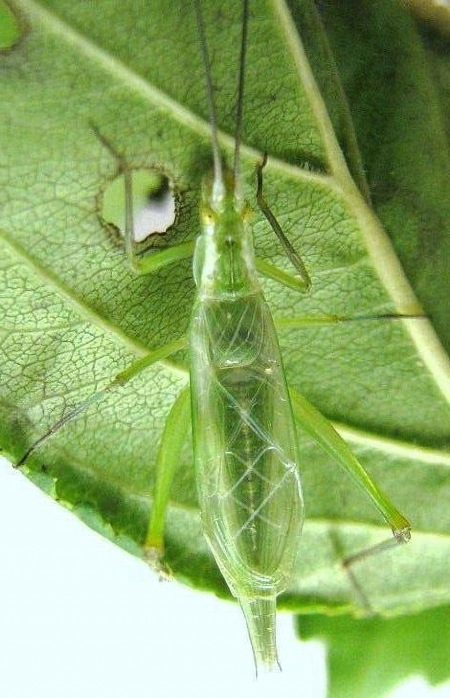Facts - Related Individuals
Oecanthus fultoni, the Snowy Tree Cricket, has many close relatives. The species was thought to be a part of the species Oecanthus niveus, but in 1962 Thomas J. Walker described O. fultoni as a separate species (Walker 1962). Text that date back before 1962, often were referring to O. fultoni as O. niveus which make research of this particular species difficult.
Image: Snowy Tree Cricket
The Snowy Tree Cricket has orange on its head along with small black dots
within larger white spots at the base of the antennae. Note the pale
green
translucent legs. They also possess wide distal wings used
for chirping (Walker
1962).

Image: O. niveus
Image: O. fultoni
The image on the right side of the
page shows close up of the head of a Oecanthus niveus, the
Narrow-Winged Tree Cricket, and on the left side is a close up of a
Oecanthus fultoni, the Snowy Tree Cricket. Notices the
slight differences of the base of the antennae of both specimens.
The Narrow-Winged Tree Cricket has a black 'J' shaped mark at the
base of the antennae and a black tear-drop shape just above the 'J'.
The Snowy Tree Cricket, in replace of the 'J'-shaped black marking
of the Narrow-Winged Tree Cricket has only a black dot. This subtle
different between the antennae of these two insects is what
differentiates them into different species (Walker
1962).
There are many species of true crickets
within the genus Oecanthus that live in North America. Each
of the species have the same general features: skinny, narrow body,
three pairs of legs and wings for making the well known chirping
sounds. But each individual have characteristics unique to its
species:

Image: Male Two-Spotted Tree
Cricket
This male Two-Spotted has creamy, pale pink wings with a
reddish-brown head and foremost section of the thorax where
the first pair of legs protrude.

Image: Female Two-Spotted Tree
Cricket
The female Two-Spotted Tree Cricket has the same reddish-brown
head and pronotum (foremost section of the thorax) but the wings
are vastly different than those of the male. Note the two large,
dark
markings connected to the darker ridges.
Image: Male Forbes' Tree
Cricket
Note the male Forbes' Tree Cricket has a green body,
legs, head and pronotum. To distinguish from other
tree crickets, this species has black antennae and the
rate of his chirp.

Female Forbes' Tree Cricket
The female Forbes' Tree Cricket looks very similar to the
male with the same green body, legs, head and pronotum.
Image: Four-Spotted Tree
Cricket
This male Four-Spotted Tree Cricket has a whitish-green
color with pale limbs and antennae. The distinguishable
feature are the yellowish eyes.

Image: Pine Tree Cricket
Note the rusty-colored head of this male Pine Tree Cricket.
The rust color continues into the pronotum and limbs, matching
the bark of the conifer trees on which it resides.

Image: Different-Horned Tree
Cricket
The Different-Horned Tree Cricket has bright red on the head
(sometimes the head can be a tint of pink or purple). Note
dark antennae.

Image: Oecanthus walkeri (Oecanthus
walkeri)
Above is a male Oecanthus walkeri. This species was
newly discovered
in the deep south of Texas in May 2012 where it was first published
in the
Journal of Orthoptera Research (Collins
and Symes 2012). This species has
narrow wings, yellow eyes and bright white at the base of the
antennae.
Above are only a handful of many
species described. As one can see, there are a plethora of species
of tree crickets. Even as recent as 2012, when the Oecanthus
walkeri was described, there is a common notion that many more
are yet to be discovered. Each species have their own
characteristics that differentiate each one down to the patterns on
their wings, antennaes, bodies and legs as well as their own unique
calls.